Affiliate disclosure: This post may contain affiliate links. Please see our Privacy Policy.
A friend of mine spends her summer weekend trying to wipe knotweed off the face of the earth. She comes back from trips exhausted, having used everything (including fire) to try to eradicate a patch of knotweed, only to find it in the very same spot the next year.
It’s an exotic invasive, but it is, in fact, a native plant in Japan. How do they deal with it there?
They do the only sensible thing you can do when a plant just won’t stop growing. You eat it!

Is Japanese Knotweed Edible?
Yes! Japanese knotweed is edible, and it’s tasty. It’s also medicinal, but more on that later. Once you know that it’s edible, I hope that you’ll look at this plant with a new perspective.
There are dozens of ways to eat Japanese knotweed, and I’ve included links to over 30 recipes at the end of this post. Everything from pies, and candies to quiches, curries, and pickles.
What does Japanese Knotweed taste like?
Most people say that it tastes a bit like a gamey version of rhubarb. Or a greener version of rhubarb.
I handed a stalk to my rhubarb-loving daughter and she bit right in and asked for more. It does taste like rhubarb, but with less acid and ever so slightly more “vegetable” taste. Rhubarb tastes more like a fruit, while knotweed is the other half of the coin, the vegetable version.
Cooked knotweed tastes more like asparagus than rhubarb, at least to my palate. The subtle tart fades away and it’s just a pleasant vegetable.
Medicinal Uses of Japanese Knotweed
There’s some promising research looking into Japanese knotweed as a treatment for Lyme disease. I first came across this in an Instagram feed from a local Vermont Herbalist at Old Ways Herbal:
I wish I could find a more scientific source, and I’m still searching for an actual scientific study to cite. Until then, this comes from Every Home Remedy,
“Japanese Knotweed Lyme specifically targets leptospira and treponema denticola types of Lyme diseases. It is considered to be the most effective herbal way to lower, or even eliminate Lyme disease and its symptoms. It supports the innate immune function to react to the infection caused by the Lyme disease. It kills the spirochetes that are found in difficult-to-reach areas by enhancing the blood flow and also helps other drugs to be more effective.”
Knotweed is also traditionally used to treat a number of conditions, including respiratory issues and skin conditions. It’s used to stop bleeding, and as a mouthwash as well. There is some evidence that it may be helpful specifically for gingivitis, and according to WebMD,
“Developing research suggests that a root extract of knotweed might be useful as a mouth rinse to treat gingivitis. Gingivitis is caused by plaque, a film of saliva and bacteria that builds up on teeth at the gum line. The knotweed extract seems to decrease bleeding and swelling of the gums, possibly because it might interfere with the formation of plaque.”
Identifying Japanese Knotweed
The first step to eating Japanese knotweed is finding it. Knotweed grows along roadsides and stream banks, and anywhere there’s continuous disturbance. Ironically, all the efforts to eradicate it only create more disturbance, and help to promote favorable conditions for more invasive growth.
Knotweed looks different as the season progresses, but the best time to eat it is when the shoots are young in the spring. In the early spring, the stalks unfurl with beautiful color and bamboo-like growth. Here’s a patch right alongside a country road, at the top of a streambank.

The shoots are bright green with pink/red divisions between sections. Take a look at the closeup below of a Japanese knotweed shoot.
If you cut into it, the stalk will be hollow except right where the pink line divides sections of growth. Leaves emerge from these division points.
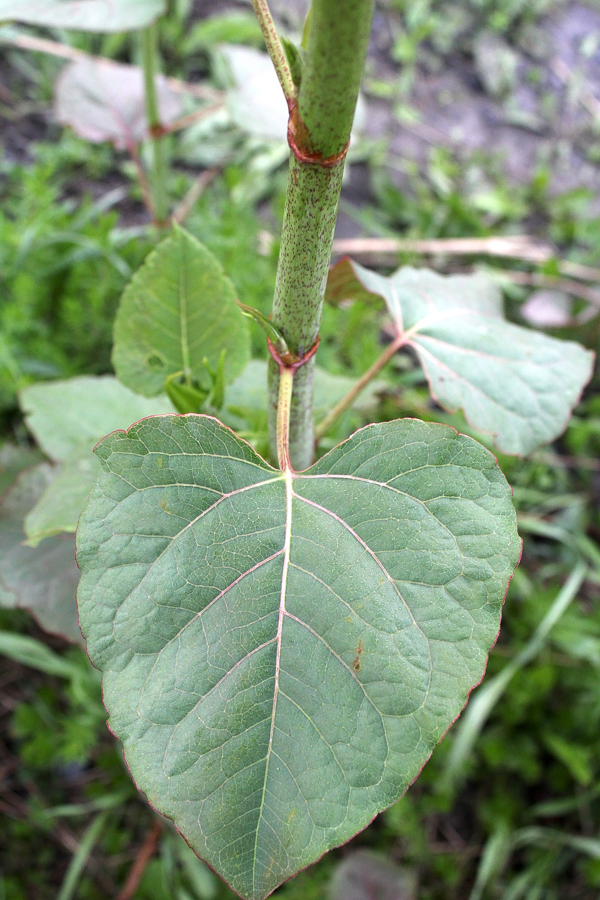
The growing tips are pointed and curled as they reach skyward. When they’re very small, the leaves will be tightly curled around a central cone and it’ll vaguely resemble an arrowhead pointing upward.
As the season progresses, these young shoots can grow to 8 feet tall.
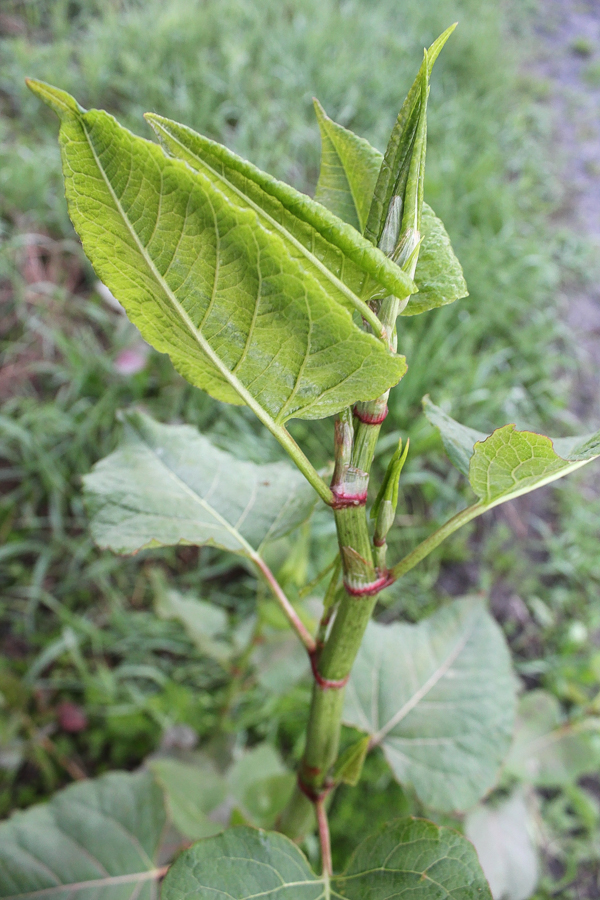
The young leaves can have a magenta hue, and the veins can range from magenta to white, turning lighter as the leaves get older.
For eating, you’re mainly concerned with the stalk and the leaves will be removed. The stalk is edible so long as it’s tender, and it’ll get woody as the plant gets older.

The stalks are hollow, like bamboo, and that leaves interesting culinary options. Some recipes make use of this and stuff the knotweed shoots.
I’ve seen hummus stuffed knotweed shoots, and a version of ants on a log with a knotweed shoot split lengthwise, filled with peanut butter and topped with raisins. Knotweed has a pleasant crunch, and it’d make a great stand-in for celery snacks.
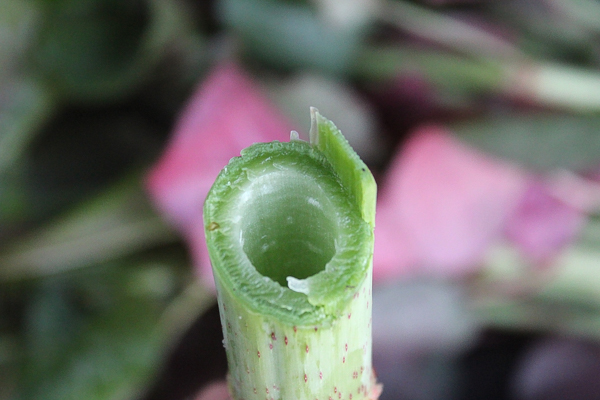
Japanese Knotweed Recipes
There are so many ways to cook Japanese knotweed, and I’ve included a selection of recipes below. I personally made Japanese knotweed mini pies and there’s a knotweed gin infusing on my counter. I recently learned that rhubarb-infused gin is a popular drink and the tart notes in the rhubarb make a lovely cocktail.
I’m hoping that the knotweed will come through in the same way. It also has the added bonus of accidentally being a knotweed tincture, so I can drink my medicine this summer.
Knotweed Main Courses
- Japanese Knotweed Quiche – Kitchen Vignettes
- Sour Japanese Knotweed Soup – Very Vegan Val
- Knotweed and Lamb Curry – 66 Square Feet
- Fava Bean and Knotweed Meatballs – 66 Square Feet
- Japanese Knotweed Risotto – 66 Square Feet
- Knotweed Gazpacho – The Foraged Foodie
- Knotweed and Ramp Sushi – The Foraged Foodie
- Knotweed and Pork Banh Mi – The Foraged Foodie

Knotweed Desserts
- Japanese Knotweed Sorbet – Forager Chef
- Japanese Knotweed Bars – Leda Meredith
- Knotweed Mousse Cake with Maple Buttercream – Forager Chef
- Knotweed Pudding Cake – The Three Foragers
- Strawberry Knotweed Crisp – Our One Acre Farm
- Japanese Knotweed Syrup – The Three Foragers
- Japanese Knotweed Cold Dessert Soup – The Three Foragers
- Knotweed Tapioca – The Three Foragers
- Knotweed Dessert Squares – The Three Foragers
Knotweed Drinks
- Knotweed Peasant Wine – The Three Foragers
- Japanese Knotweed Vodka – The Guardian
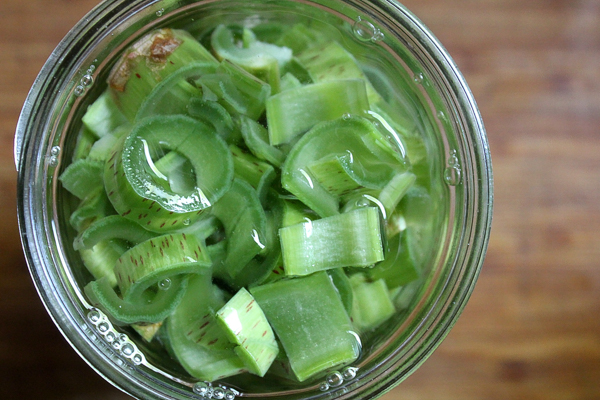
Knotweed Snacks and Sides
- Boiled Knotweed with Sesame and Vinegar – Herbal Academy
- Knotweed Vinegar Pickles – 66 Square Feet
- Knotweed Pickles – The Foraged Foodie
- Knotweed Salsa Verde – The Foraged Foodie
- Japanese Knotweed Puree – Forager Chef
- Japanese Knotweed Bread – Edible Wild Food
- Knotweed Fruit Leather – Forager Chef
- Knotweed Muffins/Quick Bread – The Three Foragers
- Knotweed Summer Rolls Appetizers – The Three Foragers
- Knotweed Pico de Gallo – The Foraged Foodie
- Japanese Knotweed Jelly – The Three Foragers
- Traditional Salted Japanese Knotweed – Nakazora
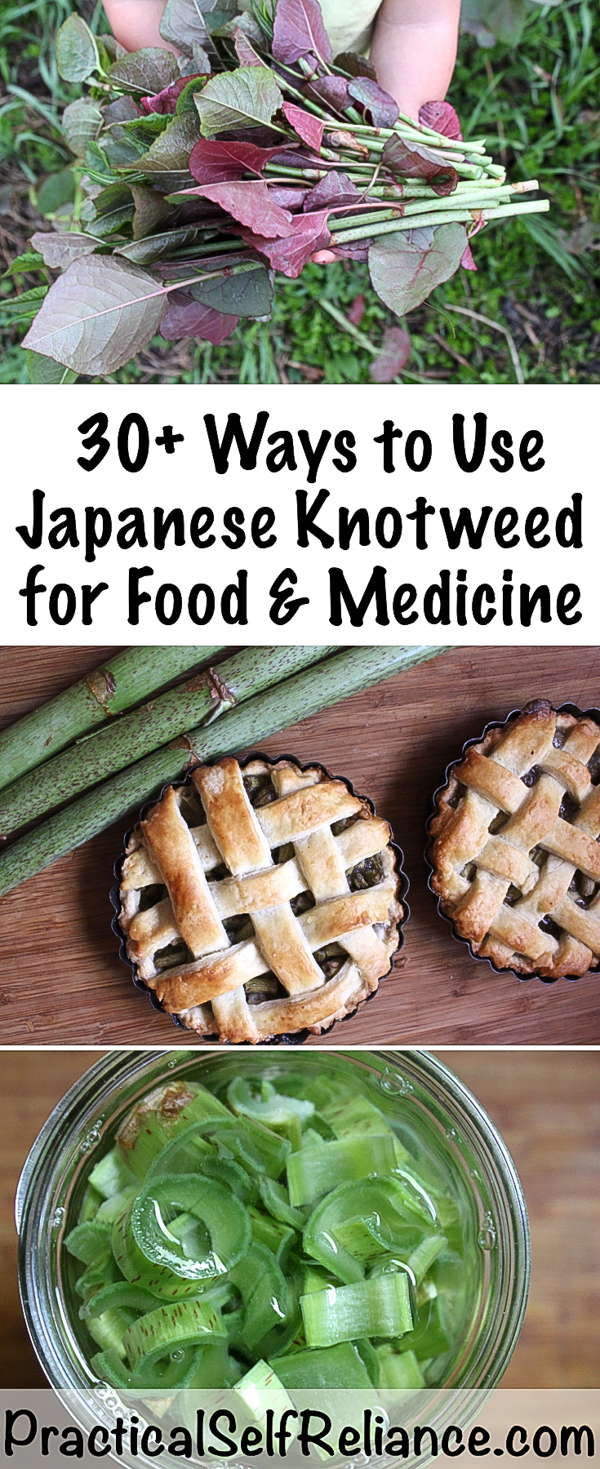




My government county conservation department sprayed Japanese Knotweed on my property and killed 9 of my trees, some as large as 40 feet. The poison spray label said it was not to be applied within a half mile from a lake, however, I live on a small lake. They disagreed, but said they would cut the dead trees and replant new trees. New trees were 6 to 8 feet tall so I will never enjoy their shade since I’m elderly. I also was very sick the year after the spraying and spent time in the hospital. That was horrible as I work every morning with nausea. Very bad experience.
Oh wow I grew up in the finger lakes where we had a patch of this stuff on a shale hillside. I just noticed some growing in my rose bushes. I wondering can i feed it to my chickens and rabbits? It’s growing so fast! In the TX Rainy season. I best get started harvesting the heck out of it and attempting to kill it off.
It is my understanding that it is not poisonous and is safe for humans and animals.
ABSOLUTELY!!! ALL of my animals will break down fences to get to it!! And it is infinitely good for them as it is so full of minerals because of the rhizomes being so deep in the soil.
Gloria, we tried to hire a goat herd to control the knotweed. Multiple goat farmers say their goats won’t eat it; so I am surprised to read that your animals do eat it.
Hi Ashley, have you tried searching for Medicinal uses of Japanese Knotweed + Lyme Disease in google scholar? It searches only through scientific articles on google scholar.
Also if you use the plus + with your keywords in google, it will be searching for combinations of those words exactly.
Here s a link to have a look at. Hope it brings you some new info to look at. https://scholar.google.com/scholar?hl=en&as_sdt=0%2C5&q=Japanese+knotweed+as+a+treatment+for+Lyme+disease&btnG=
Thanks for sharing that. We’ll check it out.
If I want to make a quart of tincture how much root do I need? 1/2 , 2/3 cup????
I would just put whatever amount of knotweed that will fill the jar and then cover it with alcohol.
Big thumbs up for Stephen Buhner’s books….he speaks highest of using Japanese Knotweed (Polygonum Cuspitdatum) for Lyme treatment (also analyzes many other plants as well). One can buy it in bulk powder and other forms from 1st Chinese Herbs here in Washington state. They have both Plum Brand and NuHerbs.
I love this site, and will try to get my hands on some fresh knotweed to try some of these recipes!!
Thank you~
You’re very welcome. So glad you enjoyed the post.
Hello ! Found your site because I have been trying to get a hold of Japanese Knotweed to grow. We have a small permaculture homestead in CA and I am interested in it for several medicinal reasons. I have not been able to get seedlings or seeds. I am wondering if you or someone reading this site would be interested in selling some if it grows where you live? We are in a dry part of California so I am not worried about spreading it and will most likely grow it in a container to be safe.
Love your site!
Thank you,
Sarah Forsythe MD
You might want to check your local regulations to be sure that you are able to plant there since it is a very invasive species.
I have been struggling with knotwood and have plenty in my back yard. It grows so fast I am old and can barely keep up with it anymore. If you want it, come and get it.
I traveled from Minnesota to Mississippi in search of KNOTWEED. Found nothing but then again it may have been to early to spot . This was May. I came home and traveled another 3hours to where it is invasive.. a nice lady let me harvest as much fruit as I wanted. And we did 4 hours of digging and now it’s been 5 days trying to wash all the thick mud off the roots finally got that done after 3 days of working at it now it’s the roots those roots are like rock.
I have used a hatchet a sledgehammer a hatchet with the hammer and it’s very very difficult this is day five and I’m still trying to get through that big root any ideas to make this a little easier?
No ideas, unfortunately, it’s really hard to get through!